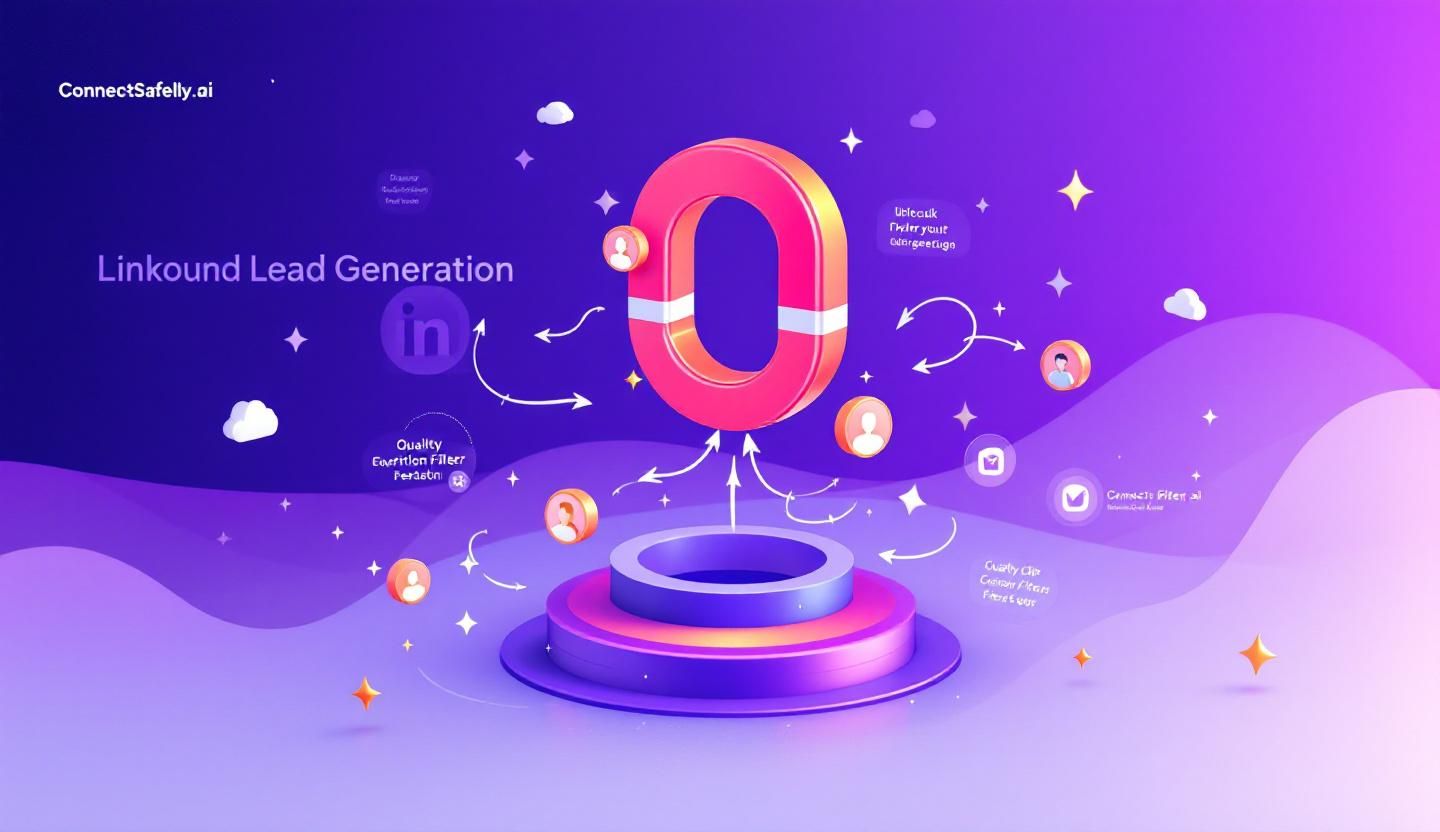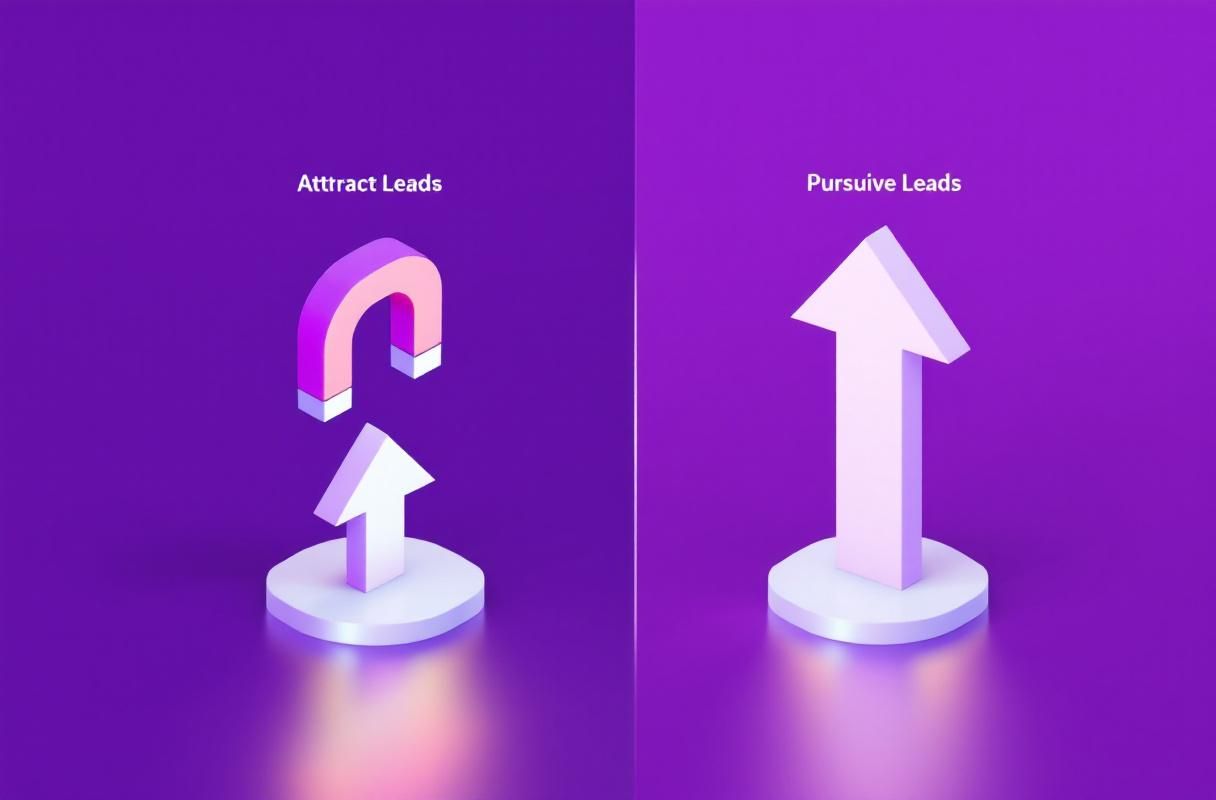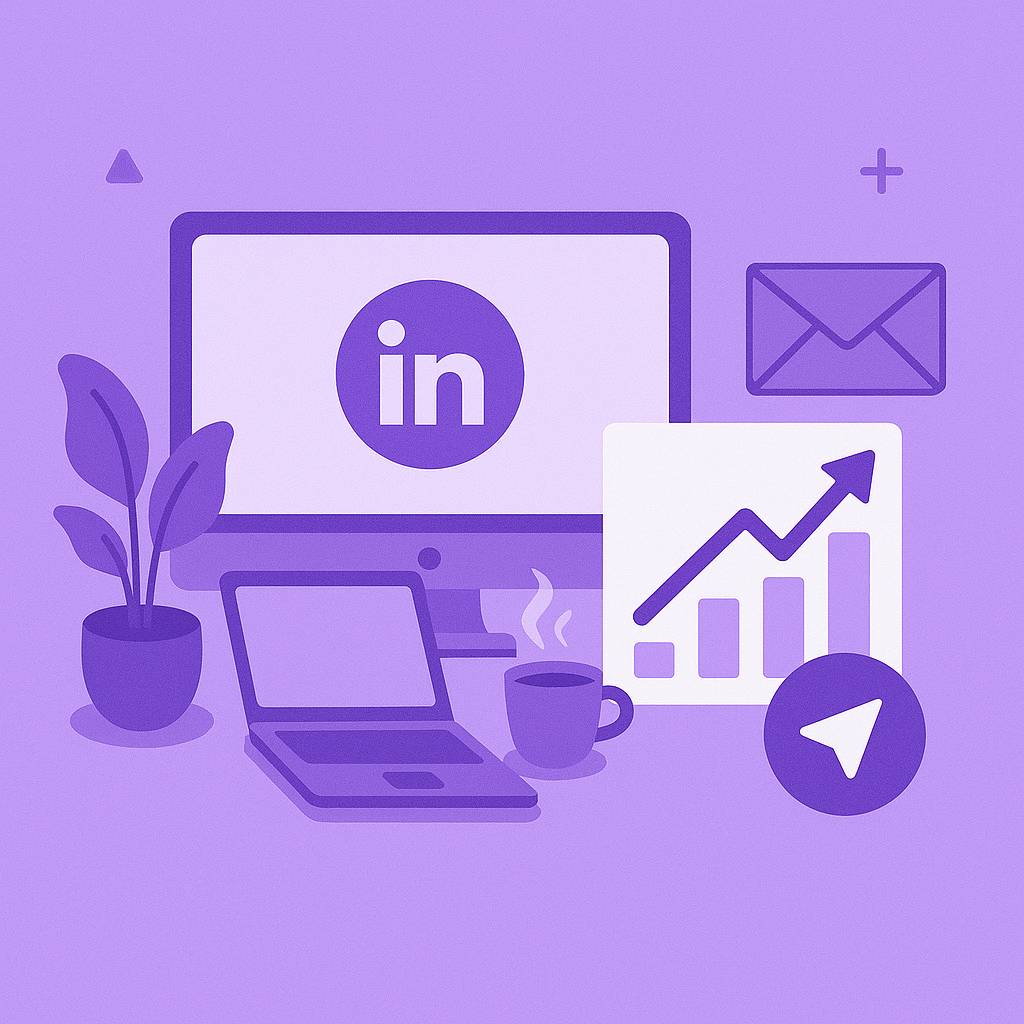Why Platform-Native Inbound Engagement Beats Desktop Automation Tools (And Keeps Your Account Safe)
Desktop automation tools promise safety but still chase leads. Discover why LinkedIn's platform rewards inbound engagement over any form of automation—and how to attract qualified prospects without software risks.

Everyone searching for "safe LinkedIn automation" eventually discovers desktop tools. The pitch sounds compelling: run automation directly from your computer, avoid cloud detection, protect your account. But here's what they don't tell you: The safest LinkedIn strategy isn't finding better automation—it's eliminating the need to automate cold outreach entirely.
Desktop automation tools are solving the wrong problem. They help you chase leads more safely. Meanwhile, LinkedIn's 2024-2025 algorithm changes reward something completely different: authentic engagement that positions you as an authority prospects actively seek out.
The Desktop Automation Sales Pitch (And Why It Misses the Point)
Desktop LinkedIn automation tools market themselves as the "safe" alternative to cloud-based automation. Their argument:
The Desktop Tool Promise:
- "Runs on your own machine, not detected like cloud tools"
- "Uses your actual IP address, appears more legitimate"
- "Mimics human behavior better than browser extensions"
- "No third-party servers accessing your LinkedIn account"
- "Lower ban risk because it's 'more authentic'"
The Reality Behind the Marketing:
While desktop tools may reduce some technical detection vectors, they still violate LinkedIn's Terms of Service Section 8.2, which explicitly prohibits "using bots or other automated methods to access the Services, add or download contacts, send or redirect messages."
More critically, they still automate the wrong activities—cold connection requests, bulk messaging, profile scraping. LinkedIn doesn't just detect how you automate; it detects what you're automating. And in 2024-2025, the platform fundamentally opposes high-volume cold outreach regardless of the technical approach.
Why LinkedIn's Algorithm Evolution Makes All Automation Obsolete
The 2024-2025 Platform Shift
LinkedIn's recent changes reveal their strategic direction clearly:
Connection Request Restrictions:
- Reduced from 100 per day to 100 per week (71% reduction)
- Clear signal that volume outreach is unwanted
- Weekly limits apply regardless of automation method
- Manual sending doesn't bypass the restrictions
Algorithm Prioritization Changes:
- Now rewards "knowledge-rich content" and demonstrated expertise
- Evaluates posts on: Relevance, Expertise, Engagement quality
- Comments boost reach 15X more than likes
- High-quality engagement extends content visibility to 2-3 weeks (new in 2025)
Detection Sophistication Increases:
- Pattern recognition identifies repetitive behavior (even "human-like" patterns)
- Engagement velocity monitoring (too consistent = suspicious)
- Content quality analysis (generic comments flagged)
- Cross-account behavior correlation (same patterns across users)
The Strategic Insight:
LinkedIn isn't trying to catch desktop tools specifically—they're trying to reduce cold outreach entirely because it creates poor user experience. Whether you send 50 templated connection requests via desktop tool, cloud automation, or manually, LinkedIn sees the same spam pattern.
The Fundamental Problem: Automation Targets the Wrong Activity
Both desktop and cloud automation tools help you do one thing faster: interrupt strangers who don't know you exist.
What Automation Tools Automate:
- Connection requests to people who haven't heard of you
- Follow-up messages to cold connections
- Profile visits hoping for reciprocal attention
- Generic "congratulations" comments for visibility
What Actually Generates B2B Leads on LinkedIn:
- Consistent visibility in conversations your ideal clients read
- Demonstrated expertise in your domain
- Thoughtful contributions that add genuine value
- Authority positioning that makes prospects seek you out
The Disconnect:
You're automating activities that prospects find annoying (cold outreach), instead of scaling activities that attract them (strategic engagement and authority-building).
The Inbound Alternative: Platform-Native Engagement Strategy
What "Platform-Native" Means
Instead of using external software to automate cold outreach, adopt strategies that work with LinkedIn's algorithm rather than against it:
Platform-Native Engagement Activities:
- Commenting on posts from creators your ideal clients follow
- Sharing insights that demonstrate your expertise
- Engaging in conversations where decision-makers are active
- Building visibility through value-added participation
Why LinkedIn Rewards This:
- Increases time on platform (users stay longer reading discussions)
- Improves content quality (thoughtful comments enhance posts)
- Strengthens community (authentic interactions build connections)
- Aligns with revenue model (engaged users see more ads and premium features)
The Critical Difference:
LinkedIn's algorithm actively boosts authentic engagement because it improves user experience. When you comment thoughtfully on a post with 10,000 views, LinkedIn may show your comment to thousands—essentially giving you free reach. Try that with cold connection requests and you'll hit weekly limits immediately.
The Inbound Methodology Explained
Instead of chasing hundreds of cold prospects with automation (desktop or otherwise), position yourself where ideal clients already pay attention:
Step 1: Identify Strategic Conversations
- Find posts from thought leaders your ICP follows
- Target content discussing problems you solve
- Prioritize high-engagement conversations (viral content = more visibility)
Step 2: Contribute Genuine Expertise
- Add insights that demonstrate your knowledge
- Reference specific elements from the post (prove you read it)
- Share relevant experience or data points
- Avoid generic praise ("Great post!") and add substantive value
Step 3: Maintain Consistent Presence
- Engage daily in key conversations
- Build recognition through repeated valuable contributions
- Allow prospects to discover you organically through your comments
- Establish authority over time rather than forcing immediate connection
Step 4: Attract Inbound Opportunities
- Profile views increase from strategic engagement
- Prospects visit your profile after seeing valuable comments
- Connection requests arrive from ideal clients organically
- DMs start with "I've been following your insights" instead of cold pitches

Why Inbound Engagement Outperforms Any Automation
1. Conversion Rate Advantage: 8-9X Better
Desktop Automation Approach:
- Send 100 connection requests per week (new limit)
- Average acceptance rate: 30-45% = 30-45 new connections
- Message those connections with pitch
- Response rate: 9.36% for AI-personalized, 2.60% for generic
- Net result: 1-4 qualified conversations per week
Inbound Engagement Approach:
- Comment strategically on 10-15 high-visibility posts per week
- Each comment seen by thousands of ideal clients
- Profile views increase 200-400%
- Inbound connection requests from interested prospects: 15-25 per month
- Response rate to your messages: 70%+ (they already know you)
- Net result: 10-18 qualified conversations per month
The Data:
- Inbound leads convert at 14.6% close rate vs. outbound's 1.7% (HubSpot research)
- Inbound sales cycles are 3-5X faster than outbound
- Cost per lead is 39-61% lower for inbound ($135 vs $186)
2. Time Efficiency: Work Smarter, Not Longer
Desktop Automation Time Investment:
- Initial setup: 3-5 hours (campaigns, templates, targeting)
- Daily maintenance: 30-45 minutes (monitoring, adjusting)
- Weekly list building: 2-3 hours (finding new prospects)
- Messaging qualification: 1-2 hours (filtering responses)
- Total: 8-12 hours per week
Inbound Engagement Time Investment (With ConnectSafely.ai):
- Initial setup: 30 minutes (define ICP, select creators to target)
- AI-powered strategic commenting: Automated
- Daily monitoring: 10 minutes (review engagement, track leads)
- Responding to inbound: 1-2 hours (qualified conversations only)
- Total: 2-3 hours per week
Time Savings: 6-9 hours per week redirected from prospecting to closing.
3. Safety & Compliance: Zero Risk vs. Ongoing Risk
Desktop Automation Risks (Real, Despite Marketing):
- Violates LinkedIn Terms of Service Section 8.2 (automation prohibition)
- Pattern detection identifies repetitive behavior regardless of software location
- Account restrictions increasing even for "safer" desktop tools
- Professional reputation damage from obvious templated outreach
- Constant cat-and-mouse game with platform detection
Inbound Engagement Safety:
- 100% LinkedIn-compliant (engagement is wanted platform behavior)
- Algorithm boost for quality contributions (LinkedIn rewards this)
- Zero ban risk (you're doing exactly what the platform wants)
- Reputation enhancement (recognized expert vs. spam sender)
The Strategic Reality:
LinkedIn can ban desktop automation users just as easily as cloud automation users—both violate TOS. But they cannot ban authentic engagement because it's the core platform activity they want to encourage.
4. Lead Quality: Warm Prospects vs. Cold Interruptions
Desktop Automation Lead Quality:
- Prospects don't know who you are
- Starting position: "Who is this stranger in my inbox?"
- Require extensive education and nurturing
- High drop-off rate during qualification
- Often not actually decision-makers (targeting imprecision)
Inbound Engagement Lead Quality:
- Prospects already familiar with your expertise
- Starting position: "I've been following your insights"
- Pre-educated on your approach and value
- Self-qualified (they reached out because they're interested)
- Higher percentage of actual decision-makers
Real-World Impact:
When prospects arrive via inbound, they've already consumed your content, understand your perspective, and decided you're worth talking to. Desktop automation just gets you in the door—with someone who didn't invite you in.
The ConnectSafely.ai Platform-Native Approach
How We Enable Inbound Without Automation Risks
ConnectSafely.ai doesn't automate cold outreach. We automate visibility in the right conversations:
Strategic Targeting:
- Identify posts from creators your ICP follows
- Surface conversations containing your expertise keywords
- Prioritize high-engagement content for maximum visibility
- Monitor competitor mentions and industry discussions
AI-Powered Authentic Engagement:
- Generate comments that reflect your unique perspective
- Reference specific post elements (proves you read it)
- Adapt tone to match conversation context
- Add genuine value, not generic praise
Platform-Compliant Execution:
- All engagement activities LinkedIn actively wants
- Natural pacing and variation (no robotic patterns)
- Quality focus over volume targets
- Human oversight and approval options
Inbound Lead Tracking:
- Monitor profile views from target companies
- Track connection request quality and source
- Measure inbound conversation volume
- Attribute revenue to specific engagement activities
The Differentiation:
Desktop tools help you automate things LinkedIn prohibits (cold outreach). ConnectSafely.ai helps you scale things LinkedIn rewards (authentic engagement). One fights the platform; one works with it.
Real Results: Inbound vs. Desktop Automation

Case Study: B2B SaaS Sales Director
Before (6 Months with Desktop Automation Tool):
- 400 connection requests sent weekly (within new limits, across team)
- 160 acceptances (40% rate)
- 60 message responses (37% of accepted)
- 8 qualified conversations (5% of responses)
- 1-2 deals closed per quarter
- Cost: $99/month tool + 12 hours weekly team time
- Account restrictions: 2 team members received warnings
After (6 Months with ConnectSafely.ai Inbound):
- 25-30 strategic comments per team member weekly
- 45+ inbound connection requests monthly per team member
- 32+ engaged conversations monthly (71% response rate)
- 12-15 qualified opportunities monthly
- 4-5 deals closed per quarter
- Cost: $39/month + 3 hours weekly team time
- Account restrictions: Zero warnings or issues
The Transformation:
- 3-4X more deals closed
- 75% less time invested
- 60% lower cost ($39 vs $99/month)
- Zero compliance risk vs. ongoing ban anxiety
- Team morale improvement (helping vs. spamming)
Why the Inbound Approach Compounds Over Time
Desktop Automation Results Over Time:
- Month 1: Good (novelty, fresh prospects)
- Month 3: Declining (list fatigue, pattern recognition)
- Month 6: Poor (burned through connections, more restrictions)
- Month 12: Searching for new tool (current one "stopped working")
Inbound Engagement Results Over Time:
- Month 1: Building (initial visibility, first profile views)
- Month 3: Growing (recognition increasing, first inbound leads)
- Month 6: Strong (consistent inbound pipeline, authority established)
- Month 12: Compounding (LinkedIn is now #1 lead source, minimal time investment)
The Difference:
Desktop automation depletes your network asset. Inbound engagement builds your authority asset. One gets harder over time; one gets easier.
Making the Shift: From Automation to Inbound
If You're Currently Using Desktop Automation
Don't Just Stop—Pivot Your Strategy:
Week 1: Audit Current Approach
- How many connection requests per week are you sending?
- What's your actual response and conversion rate?
- How much time are you investing in list building and messaging?
- What's the quality of conversations you're getting?
Week 2: Identify Inbound Opportunities
- Who are the top 20 thought leaders your ideal clients follow?
- What topics/keywords do decision-makers in your ICP discuss?
- Where are the high-engagement conversations happening?
- What unique expertise can you contribute?
Week 3: Begin Strategic Engagement
- Start commenting thoughtfully on 5-10 posts daily
- Focus on adding genuine value, not promoting
- Respond to replies on your comments
- Track profile views and connection request changes
Week 4: Reduce Automation Dependence
- Cut connection request volume by 50%
- Increase inbound engagement by 50%
- Measure lead quality difference
- Redirect saved time to closing conversations
Month 2: Full Inbound Transition
- Eliminate desktop automation completely
- Scale to 15-20 strategic comments daily
- Process growing inbound requests
- Optimize based on what's working
Setting Up Your Inbound Engine
1. Define Your ICP Precisely
- Not just demographics, but behavior and interests
- Which LinkedIn creators do they follow?
- What content do they engage with?
- What problems are they actively discussing?
2. Map the Conversation Landscape
- Identify 30-50 key creators in your space
- Find recurring topics and discussions
- Note engagement patterns (what gets traction)
- Discover where your expertise adds unique value
3. Develop Your Commenting Strategy
- Create framework for different post types
- Establish your unique perspective and voice
- Balance data/insights with personal experience
- Determine optimal engagement frequency
4. Implement Tracking and Optimization
- Monitor profile views from target companies
- Track inbound connection request volume
- Measure conversation quality and conversion
- Identify which creators/topics drive best results
5. Scale With AI Assistance
- Use ConnectSafely.ai to maintain consistency
- Ensure comments reflect your expertise
- Automate discovery of relevant conversations
- Free your time for closing deals
The Platform Compliance Advantage
Why LinkedIn Actively Wants Your Engagement
LinkedIn's Business Model Alignment:
- More user engagement = more time on platform
- More time on platform = more ad revenue
- Better content discussions = higher user satisfaction
- Higher user satisfaction = more premium subscriptions
What This Means For You:
When you engage authentically, LinkedIn's algorithm works for you, not against you. They boost visibility of quality comments. They suggest your profile to people interested in your topics. They reward consistent valuable participation with increased reach.
Desktop automation fights this system. Inbound engagement harnesses it.
The 2025 LinkedIn Algorithm Rewards
What Gets Algorithmic Boost:
- Thoughtful, substantive comments (not "Great post!")
- Engagement on trending, high-quality content
- Consistent participation from recognized contributors
- Comments that spark additional discussion
- Value-adding perspectives and expertise
What Gets Algorithmic Suppression:
- Generic, templated responses
- Rapid-fire engagement patterns
- Self-promotional comments
- Low-effort contributions
- Suspicious consistency or timing
The Strategic Takeaway:
The safest LinkedIn strategy isn't better automation technology—it's better alignment with what the platform wants and rewards.
Key Takeaways: Why Inbound Beats Any Automation
-
Desktop automation is safer than cloud automation, but both violate LinkedIn TOS and miss the fundamental shift toward inbound attraction.
-
LinkedIn's 2024-2025 changes explicitly favor engagement over outreach—connection limits dropped 71% while engagement reach increased 15X for quality comments.
-
Inbound leads convert at 14.6% vs. outbound's 1.7%—an 8-9X improvement that no automation tool can deliver through better cold messaging.
-
Platform-native engagement is 100% compliant and algorithm-boosted, while all automation (desktop or cloud) carries ban risk and fights the platform.
-
Time efficiency favors inbound: 2-3 hours weekly vs. 8-12 hours for desktop automation management, with dramatically better results.
-
Authority compounds: Inbound engagement builds over time, while desktop automation depletes your network and requires constant list refreshing.
-
ConnectSafely.ai enables scaled inbound without automation risks—strategic engagement that LinkedIn rewards rather than restricts.
Ready to stop fighting LinkedIn's algorithm and start working with it?
Start your free trial and discover how platform-native inbound engagement attracts qualified prospects who already want to work with you—without desktop tools, without cold outreach, without bans.
The future of LinkedIn lead generation isn't safer automation—it's strategic inbound attraction that makes automation unnecessary.
